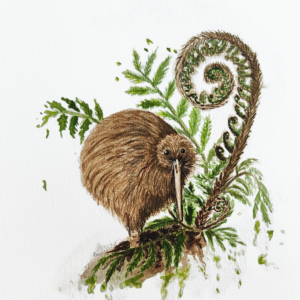Female Bellbird in Harakeke
To me this image represents unity and new beginnings.
Most New Zealanders can easily recognise the bellbird by its song, which Captain Cook described as sounding ‘like small bells exquisitely tuned’. The bellbird is known to in maori as korimako, makomako, and/or kōmako. While not listed as endangered, they once had a substantial population throughout New Zealand and now there are only a few pockets within the mainlands.
In 2010 the bellbird was rediscovered on Motutapu Island, after an absence of more than 100 years. This follows one of New Zealand’s largest ever island pest eradication programmes on Motutapu and Rangitoto Islands in 2009.
The Māori saw bellbirds as nga aitanga kapakapa a Tāne, winged children of the forest god, perhaps because of their magical song. Some believed korimako’s father was Rehua, the forest god who was the main servant of the supreme being. The bird’s cultural association with spirit and representing new beginnings and a fresh start was so strong that it played a central role in Māori baptism: a living korimako was touched to the baby’s head and then released to fly freely out into the world.
Did you know:
- The male bellbird has bright red eyes while the female has a more muted wine red. Juveniles have brown eyes.
- Male Bellbirds have brighter colours than their female counterpart. Male feathers are brighter with more yellow and blue hues while females are more muted olive greens and dark brown.
- Like the Tui, bellbirds are known as Honeyeaters and are essential for pollination of our native flowers, Often they will have pollen dots on the top of their heads from putting their head into the flowers to drink nectar.
- The bellbird is known as the korimako, makomako (mako is also the Maori name for shark), or rearea among other names
- Bellbirds are slightly smaller than blackbirds at only 20cm long.
- 25 Million native birds are killed by predators each year, that’s over 68,000 birds per day
Māori cherished harakeke (NZ flax) and cultivated plants in special plantations, called pā harakeke.
For Māori, the fan-shaped harakeke plant represents a whānau (family). This symbolism reflects the importance of the plant in Māori life. The rito, or inner shoot, is likened to a child and is never removed. A family must protect its offspring if it is to survive.
They grew many varieties for specific purposes. It is a versatile, tough, hardy fibre that can be woven into skirts and cloaks, mats and baskets, fishing nets and rope, and metaphorically represents the interweaving of cultures, and of people’s hearts.
Fun facts:
- To make kākaku (cloaks), weavers extracted and processed the inner fibre of harakeke, called muka. They used this to weave the base. They also used strips of the whole leaf – to create the thatch-like protective surface of pākē (rain capes) and to adorn other styles of cloak.
- Harakeke gel can be used as a soothing antiseptic and humectant (hydrating) topical agent.
- One of New Zealand’s most distinctive native plants, harakeke is not, botanically, a flax, but a member of the day-lily family. The name flax comes from the fact that the long fibres extracted from the leaves are used in much the same way as those in linen flax (Linum usitatissimum) are used in the northern hemisphere.
- It has long, upright, often stiff leaves which can reach up to 4metres in length and the black flower stalks can grow up to 5 metres tall and the dull red, nectar-filled flowers attract masses of birds in kōanga/spring, particularly tūī and korimako.
A little more about Conservation in my local area :
Native birds such as tūī and bellbirds were once abundant in the area where Hamilton stands. Due to introduced pests (rats and possums) and loss of habitat and food sources, many of our native birds are rarely seen in our city.
The Hamilton Halo project aims to bring native birds, such as tui and bellbirds, back into Hamilton city. The ‘Halo’ is the project area – a ring drawn around Hamilton, taking in key sites where tūī breed.
Hamilton Halo’s work focuses on increasing the number of bellbirds and tūī that survive in bush breeding areas and making the city an attractive place for those birds to stay, feed and breed.
Hamilton Halo works with Hamilton City Council, community groups and landowners on pest control and plantings at key sites within the city. This helps provide year-round sources of food and safe habitat for the tūī and bellbird populations that have increased numbers in the bush and now need more habitat to breed in.
Since the Hamilton Halo project started in 2007, tūī numbers have increased significantly and tūī have started breeding in the city.


![IMG_20230208_103800_960[1]](https://leadbytheheart.com/wp-content/uploads/2023/02/IMG_20230208_103800_9601.jpg)



Reviews
There are no reviews yet.